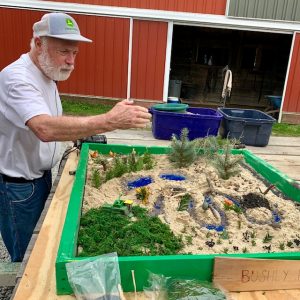On October 30, 2019, Tom Barthelmeh, a wetland restoration specialist, hosted a Wetland Restoration Workshop at his farm in Clayton, Delaware.
Tom is a former Delaware Department of Natural Resources and Environmental Control (DNREC) employee that connected with landowners, found funding, designed (in-field) and implemented many wetland and ditch projects. The intent of the workshop was to bring Tom’s knowledge and resources to implement projects for water quality to newer planners in the Delaware Conservation districts and NRCS. In addition, DNREC staff attended the day-long workshop which encouraged networking to better understand available project funding as well.
Click here to view the 2019-10-30 Wetland Workshop Agenda.
Part 1: Planning for Natural Resource Restoration on Delmarva
Jennifer Egan, Program Manager with the University of Maryland Environmental Finance Center, opened the day with information and a list of resources that conservation professionals in Delaware can use to identify sites and help plan wetland restoration projects.
Chase Colmorgen, a biologist with Ducks Unlimited, also shared how he uses different GIS resources in working with landowners to develop wetland restoration projects.
Click here to download the Powerpoint slides from this presentation.
One of the examples featured in their presentation was this case story of the Hudson Farm. Nathan Hudson is a landowner and crop advisor in Delaware who has worked with the USDA’s Natural Resources Conservation Service on multiple wetland restoration projects on his farm:
Wetland Restoration Guidance Resources
There are several GIS resources that can be used to assist with planning wetland restoration projects, including aerial photographs, topography maps, soils maps, LIDAR and others. The UMD Environmental Finance Center has developed a draft guidance document that lists desktop GIS resources, how to use them, and where the resources can be accessed by both USDA and non-USDA employees. The guidance document has 6 sections:
- Section 1 – Desktop resources and how to use them
- Section 2 – Summary of funding opportunities (federal and state)
- Section 3 – Network of contacts to provide project support
- Section 4 – Example concept sketches of wetland and water control structures (NRCS guidance)
- Section 5 – Summary of videos for online training opportunities
- Section 6 – Wetland opportunity checklist (adapted from NRCS)
Click here to access and download the guidance document.
Part 2: Tales of Conservation Planning- Working with Landowners to Adopt Whole Farm Plans
Grant DeCosta, Assistant Director for Community Services with the Brandywine Conservancy in Chadds Ford, PA, talked about his experiences working with landowners and building relationships to develop whole farm conservation plans.
Click here to download the Powerpoint slides from this presentation.
Part 3: Details Make the Difference- Designing Projects that Mimic Nature
 Tom Barthelmeh’s wetland restoration work is a familiar sight to many Delawareans and has also been featured in The Conservation Fund’s guide, “A Sustainable Chesapeake: Better Models for Conservation“.
Tom Barthelmeh’s wetland restoration work is a familiar sight to many Delawareans and has also been featured in The Conservation Fund’s guide, “A Sustainable Chesapeake: Better Models for Conservation“.
As a wetland restoration specialist for DNREC, Tom spent his career working with landowners, finding and combining funding sources for projects, and refining wetland restoration techniques. In his presentation, he shared those details and methods that make the difference in successfully mimicking nature and providing habitat and water quality benefits.
Part 4: “The Sandbox Exercise”
As part of his work in reaching out to landowners, conservation professionals and students, Tom developed a hands-on wetland restoration activity called the “Sandbox Exercise”, where participants can try out the concepts that they’ve just learned about. In this exercise, Tom divides the participants into small group, gives each group a “wish list” of wetland restoration features to include, and provides a variety of materials that they can use to build the wetland.
To conduct your own Sandbox Exercise, you’ll need:
- Jacks Wish List of wetland restoration features
- Sample Project Agreement
- Sandbox Exercise Materials List
Additional Resources
- WetlandsWork.org: A Guide for Agricultural Landowners– Wetlands Work is a resource for agricultural landowners in the Chesapeake Bay watershed. It was developed by the Chesapeake Bay Program’s Wetland Workgroup to connect landowners with the people and programs that can support wetland restoration on their land.
- Wetland Restoration in Delaware: A Landowner’s Guide, Part 1: Restoration Stories and Part 2: Resources for Restoration
Partners
This project was supported through a grant from the National Fish and Wildlife Foundation’s Chesapeake Bay Stewardship Fund, provided to The Nature Conservancy and the Sussex Conservation District.
The University of Maryland’s Environmental Finance Center, Ducks Unlimited, the USDA Natural Resources Conservation Service and Resource Smart LLC coordinated the workshop.
Many thanks to Tom Barthelmeh for his willingness to host the workshop and share his expertise!


